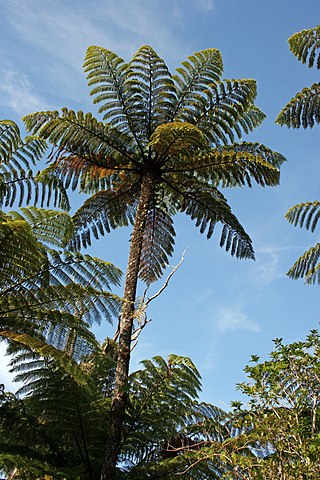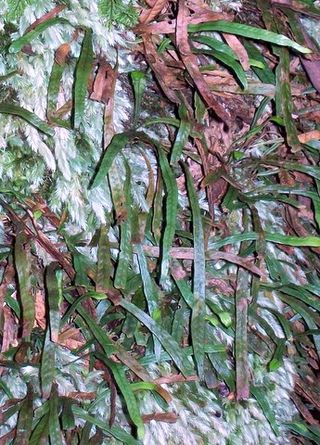
Pteris (brake) is a genus of about 300 species of ferns in the subfamily Pteridoideae of the family Pteridaceae. They are native to tropical and subtropical regions, southward to New Zealand, Australia, and South Africa, north to Japan and North America. 78 species are found in China. Some species of Pteris have considerable economic and ecological value, such as Pteris multifida, Pteris ensiformis, Pteris vittata can be used for ornamental purposes; as a hyperaccumulator, Pteris multifida and Pteris vittata can be used to control soil pollution.

Cyathea is a genus of tree ferns, the type genus of the fern order Cyatheales.

Pellaea is a genus of ferns in the Cheilanthoideae subfamily of the Pteridaceae. The genus name is derived from the Greek word πελλος (pellos), meaning "dark," and refers to the brown stems. Many members of the genus are commonly known as cliffbrakes. They primarily grow in rocky habitats, including moist rocky canyons, slopes, and bluffs.

Notholaena, cloak fern, is a genus of ferns in the Cheilanthoideae subfamily of the Pteridaceae. Ferns of this genus are mostly epipetric or occurring in coarse, gravelly soils, and are most abundant and diverse in the mountain ranges of warm arid or semiarid regions. They typically have a creeping or erect rhizome and leaves that are pinnatifid to pinnate-pinnatifid with marginal sori protected by a false indusium formed from the reflexed margin of the leaf. Members of Notholaena also have a coating of whitish or yellowish farina on the surfaces of the leaves. The farina is often limited to the abaxial (lower) leaf surface, but may occur on the adaxial (upper) leaf surface as well. Members of the related Pentagramma genus have a similar lower leaf-surface farina.

Dennstaedtiaceae is one of fifteen families in the order Polypodiales, the most derived families within monilophytes (ferns). It comprises 10 genera with ca 240 known species, including one of the world's most abundant ferns, Pteridium aquilinum (bracken). Members of the order generally have large, highly divided leaves and have either small, round intramarginal sori with cup-shaped indusia or linear marginal sori with a false indusium formed from the reflexed leaf margin. The morphological diversity among members of the order has confused past taxonomy, but recent molecular studies have supported the monophyly of the order and the family. The reclassification of Dennstaedtiaceae and the rest of the monilophytes was published in 2006, so most of the available literature is not updated.

Polystichum is a genus of ferns in the family Dryopteridaceae, subfamily Dryopteridoideae, according to the Pteridophyte Phylogeny Group classification of 2016. The genus has about 500 species and has a cosmopolitan distribution. The highest diversity is in eastern Asia, with about 208 species in China alone; the region from Mexico to Brazil has at least 100 additional species; Africa, North America, and Europe have much lower diversity. Polystichum species are terrestrial or rock-dwelling ferns of warm-temperate and montane-tropical regions. They are often found in disturbed habitats such as road cuts, talus slopes, and stream banks.

Alsophila is a genus of tree ferns in the family Cyatheaceae. It has also been considered to be a section in the subgenus Cyathea of the genus Cyathea.

Dennstaedtia is a mostly tropical and subtropical genus of ferns described as a genus in 1801. Hayscented fern, or Cup ferns, are common names for some species in this genus. Its best-known member is probably the temperate North-American hay-scented fern, Dennstaedtia punctilobula, which forms extensive clonal ground-cover colonies on level surfaces in the Appalachian area.

Grammitis is a genus of ferns in the family Polypodiaceae, subfamily Grammitidoideae, according to the Pteridophyte Phylogeny Group classification of 2016 (PPG I). It had formerly been placed in the family Grammitidaceae, but this family is no longer recognized by most authors because phylogenetic analyses of DNA sequences have shown that it is embedded in Polypodiaceae.

Tectaria is a genus of fern in the family Tectariaceae, according to the Pteridophyte Phylogeny Group classification of 2016. Halberd fern is a common name for species in this genus.

Argyrochosma is a genus of ferns known commonly as false cloak ferns. The genus is included in the Cheilanthoideae subfamily of the Pteridaceae. Species now in this genus were previously treated as members of related genera Notholaena or Pellaea but were segregated into their own genus in 1987. These ferns, of which there are about 20 species, are mostly native to the Americas, from North to South and including the Caribbean, while one species, A. connectens, is known from Sichuan, China. They are commonly found growing in cracks between rocks. Their leaves are generally shorter than 40 cm (16 in) and have rounded bluish or grayish green segments. Often the lower surface of the segments is coated in a white dust, and the sporangia contain brown spores.

Lomariopsis is the type genus of the fern family Lomariopsidaceae.

Hypolepis (beadfern) is a genus of ferns described as a genus in 1806. The word is derived from Greek, meaning "under scale". It is found in tropical and subtropical regions, primarily in the New World but also in the Old World and on various oceanic islands.

Drosera uniflora is a species in the carnivorous plant genus Drosera that is native to southern Chile, Argentina, and the Falkland Islands. It is a tiny sundew with a solitary white flower as its name would suggest. Stalked glands on its leaves, which secrete sticky mucilage at the tips, are used to capture and hold insect prey, from which the plant derives the nutrients it cannot obtain in sufficient quantity from the soil. It was formally described in 1809 by botanist Carl Ludwig Willdenow.

Lellingeria is a genus of ferns in the family Polypodiaceae, subfamily Grammitidoideae, according to the Pteridophyte Phylogeny Group classification of 2016 (PPG I).

Leptolepia is a genus of ferns in the family Dennstaedtiaceae described as a genus in 1892.

Myriopteris, commonly known as the lip ferns, is a genus of cheilanthoid ferns. Like other cheilanthoids, they are ferns of dry habitats, reproducing both sexually and apogamously. Many species have leaves divided into a large number of small, bead-like segments, the probable inspiration for the generic name. Hairs and/or scales are often present on both the upper and lower surfaces of the leaf, and their presence and appearance are useful in distinguishing between species. The genus is most diverse in Mexico, but species are found from southwestern Canada south to southern Chile, and one species is endemic to southern Africa.

Polypodium is a genus of ferns in the family Polypodiaceae, subfamily Polypodioideae, according to the Pteridophyte Phylogeny Group classification of 2016 (PPG I). The genus is widely distributed throughout the world, with the highest species diversity in the tropics. The name is derived from Ancient Greek poly (πολύ) "many" + podion (πόδιον) "little foot", on account of the foot-like appearance of the rhizome and its branches. They are commonly called polypodies or rockcap ferns, but for many species unique vernacular names exist.
Hiya is a genus of ferns belonging to the family Dennstaedtiaceae. Described in 2018, it resembles ferns of the genus Hypolepis but differs from it by multiple characteristics: scrambling, indeterminate and intermittent growth of fronds; stipule-like pinnules at the base of pinnae, and a rachis-costa architecture where the adaxial sulcus of the rachis is continuous with that of the costae and costules.

Hypolepis rugosula, is a common ground fern found throughout rainforests and wet sclerophyll forests, especially after recent disturbances in the forests.



















